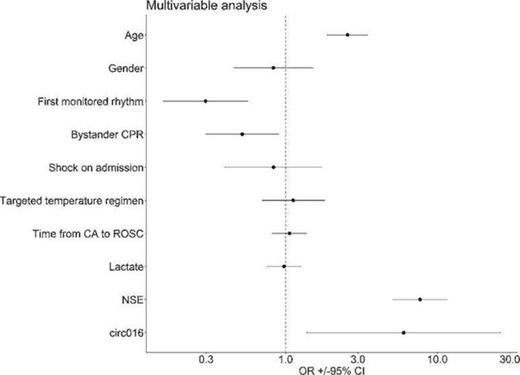-
PDF
- Split View
-
Views
-
Cite
Cite
F Stefanizzi, L Zhang, N Nielsen, Y Devaux, A Salgado-Somoza, EU-CardioRNA COST ACTION CA17129, supported by COST (European Cooperation in Science and Technology). , Circular RNAs as prognostic biomarkers after cardiac arrest, European Heart Journal, Volume 41, Issue Supplement_2, November 2020, ehaa946.3660, https://doi.org/10.1093/ehjci/ehaa946.3660
Close - Share Icon Share
Abstract
More than 400,000 cases of cardiac arrest (CA) occur every year in Europe and only 10% of these patients survive without major neurological sequelae. Predicting outcome after CA would allow adapting healthcare. However, current prognostication modalities and biomarkers lack accuracy, requiring the discovery of new ones. Previous studies suggest that circulating noncoding RNAs (ncRNAs) constitute a reservoir of novel biomarkers. In particular, circular RNAs (circRNAs), a class of long ncRNAs, appear to have a promising biomarker potential.
We aimed to identify circulating circRNAs able to predict neurological outcome and survival after CA.
Whole blood samples were collected from patients of the Target Temperature Management trial (TTM-trial; NCT01020916) 48h after CA in PAXgene RNA tubes. A discovery phase was conducted by RNA sequencing in a subgroup of 46 patients, among which 23 survived with no major neurological sequelae (cerebral performance category score 1 – CPC1) and 23 died within 6 months (CPC5). A validation phase was conducted by quantitative RT-PCR in 542 patients. Logistic regression was used to assess the association between circRNAs and 6-month neurological outcome. Kaplan Meier curves and Cox regression were used to test the ability of circRNAs to predict patients' survival at 6 months.
The discovery phase identified 282 circRNAs in blood samples. Among these, twenty-one circRNAs were differentially expressed between patients with CPC1 and patients with CPC5 (p<0.05). Experiments using RNAse R digestion confirmed the circularity of selected circRNAs. In the validation phase with 542 patients, one circRNA (circ016) was differentially expressed between patients with good neurological outcome at 6 months (CPC1–2) compared to patients with poor neurological outcome (CPC3–5) (p<0.001). Univariate analysis confirmed the association between circ016 and neurological outcome (odds ratio (OR) [95% confidence interval (CI)] 6.1 [2.2–16.7]). After adjustment with clinical and demographic parameters, circ016 remained a significant predictor of neurological outcome (OR [95% CI] 6.0 [1.4–26.1]) (Figure 1). In Kaplan-Meier analysis, circ016 was associated with 6-month survival (log rank test p<0.001). In Cox regression, circ016 predicted 6-month survival with a hazards ratio of 4.4 [2.1–9]. Patients with high levels of circ016 were at high risk of poor neurological outcome and death.
Circulating levels of circRNAs measured 48h after CA are associated with neurological outcome and survival at 6 months. We have identified several circRNAs with potential to aid in outcome prediction after CA. These circRNAs remain to be independently validated in large patient cohorts.

Figure 1
Type of funding source: Public grant(s) – National budget only. Main funding source(s): National Research Fund of Luxembourg, Ministry of Higher Education and Research of Luxembourg
- cardiac arrest
- heart diseases
- biological markers
- budgets
- demography
- digestion
- endoribonucleases
- luxembourg
- pancreatic ribonuclease
- sequence analysis, rna
- body temperature
- brain
- ribonucleases
- temperature
- rna
- whole blood
- prognostic marker
- cox proportional hazards models
- neurologic complications
- quantitative real-time polymerase chain reaction
- research funding
- univariate analysis
- higher education
- circular rna



